How to paint watercolor flowers for beginners – Step by step

Flowers are probably one of the most popular subjects for any artist. There are so many different styles and ways to paint them. From loose and atmospheric to precise botanical illustrations. The choice is huge.
Artists love to paint flowers in watercolor. I think there’s something about the transparent quality of this medium which lends itself so well to floral artwork. And they are a perfect subject for beginners ! This is my little contribution to anyone getting started with watercolors.
Do you want to learn an easy way to paint watercolor flowers?
Here’s how to paint a beautiful flower composition, using various techniques, in an easy, step by step tutorial. You begin by tracing the outlines in pencil using the template provided, then you mask the flower shapes to protect them while painting the background. Finally you add detail to the flowers themselves.
I’m going to explain in detail how to paint this flower composition, and I’ll also teach you the vocabulary and techniques needed as we go along.
I’ve been painting with watercolor since I was a kid. But I’d by no means consider myself an expert. If I can do this, I feel confident you can do it too! And to help you along, you can download my template for sketching the exact same outline that I used for this project.
Becoming a better watercolor artist takes practice and patience. Above all I hope you enjoy the process of creating your own painting, and if you make a mistake, don’t worry ! That’s what learning is about. Just enjoy the process and next time you’ll understand better what to do.
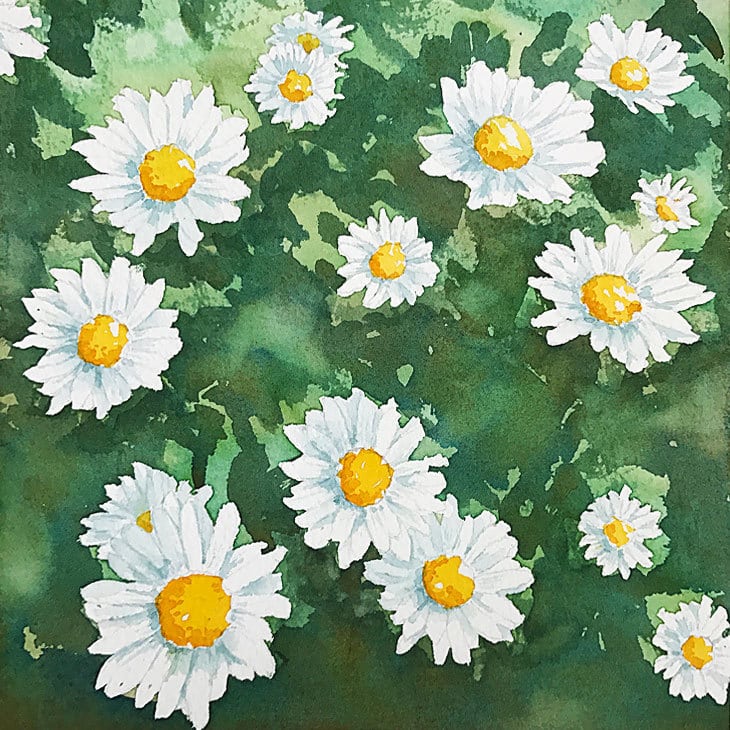
Watercolor flower techniques you will learn
This particular subject makes use of a number of techniques which you will use repeatedly when painting with watercolors. Learning the methods and the jargon whilst having fun doing some real painting is an excellent way to progress. So I’ll do my best to explain the methods you’re using so that you’re painting and learning at the same time.
The techniques that you’ll encounter during this still life project include reserving whites with masking fluid, wet on wet, glazing, and texture effects such as dry brushing, watersplatters and scumbling. We’ll also go over some topics such as color harmony, composition, and values, which will contribute to your overall understanding.
About this flower painting
The subject is a cluster of bright white daisies on a background of green vegetation. I have tried to set up the composition of the painting so that the daisies are the focus of the painting whereas the background is designed to enhance them and make them stand out. This was achieved using contrasting values and distinctly different painting styles for the focal points and the background.
Let me try and explain…
Values or tone are an important part of any artwork. The term “value” simply refers to differences in tone ranging from dark to light. You can use values as a compositional tool when designing your artwork. Because your eye is naturally draw to the point of greatest contrast, you can create highlights and focal points by using highly contrasting tones next to each other.
This is why I chose to mask the flowers so that the white paper would remain untouched while painting a dark background. This method is known as “reserving the whites”.
To further enhance the daisies as the focus of the painting I have painted them with hard edged detail (using glazing), whereas the background is painted in a loose abstract way. In a similar way to a photo which focuses on a subject while the background remains blurred and indistinct, this technique helps reinforce the subject.
The colors used for this painting use an analogous color design. Analogous colors are hues that are close to each other on the color wheel, (a color wheel is a very useful tool for designing color compositions and understanding watercolor mixing). In this case we have greens, yellows, and yellow-orange colors.
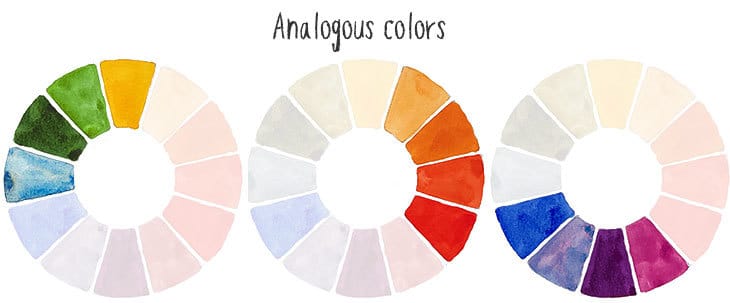
Analogous colors like these produce a harmonious gradient of hues.They are often found in nature and are said to be perceived as calm and soothing.
The paint colors used for this project were as follows:
- Phthalo blue (GS) + New gamboge. Together they mix a nice bright sap green.
- Phthalo blue (GS) + Raw Sienna. When mixed you get some nice dark greens.
- Raw Sienna + Phthalo Green. Together these produce a medium leafy green.
- New gamboge + Pyrrol Scarlet. This was used for the orange centers of the flowers.
- Quinacridone Pink + Phthalo Green. Mixed together in a very diluted blend to produce a light grey color.

These six colors are enough. If you don’t have exactly the same, try to use an equivalent. The most important thing is to keep the color temperature the same. For example Phthalo Blue (GS), Phthalo Green, and Quinacridone Pink are all cool colors. The others tend to be warm. If you’re having trouble choosing which watercolor paints to use, feel free to take a look at my recommendations.
How to paint watercolor flowers step by step
Download the watercolor flower template here. This is the exact sketch that I used for this painting. You can use this to trace the outline of the flowers for this project. My own painting measures about 7 x 7 inches (18 x 18cm).
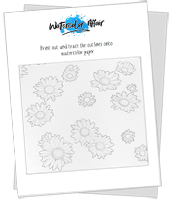
Step 1 – Getting prepared
Begin by clearing a good amount of space on a flat surface near to some natural light if possible. I find that an uncluttered workspace makes the process so much easier. Do your painting at a time of day when you can be calm without interruptions. Switch off your phone and ignore the world for a while…
Here are my suggestions for the material you should use for this project:
Watercolor maskingfluid.
- You’ll need this for masking the white flower petals during this project. This stuff is incredibly useful so if you don’t have any I highly recommend it. It’s not expensive and will be a good addition to your painting tools. Masking fluid (sometimes called frisket or even drawing gum) is basically liquid latex. Watercolor artists use this trick often because it makes painting background washes so much more simple. There are lots of different brands available. Winsor & Newton make a good product and Pebeo Drawing Gum is much appreciated by artists because it’s colored to make application easier.
Find the right brushes.
- Round brushes are all you will need for this painting. Ideally a medium and a small size. I used a round number 8 (silver black velvet) for most of the project and a smaller sable number 2 for the details. You’ll also need a small brush for applying masking fluid, preferably something which you don’t mind if it gets ruined !
Use the right paper.
- Watercolor paper is a must for this project. You’ll get the best results using 100% cotton paper, but use whatever you can afford, so long as the paper is quite heavy. The paper is going to get soaked when you paint with a wet on wet technique so you need something which can resist a large amount of wetness. I used 300 gsm / 140 lb Arches watercolor paper for this exercise.I would also recommend you use cold pressed paper. This has a slight texture and is probably the easiest watercolor paper for beginners. Rough papers can make smooth brush strokes more difficult, and smooth hot pressed paper is unforgiving because it tends to show up any flaws.
A board for attaching your paper.
- You’ll need a flat rigid board for fixing down the paper while painting. there are lots of alternatives you can try, such as marine grade ply board (resists warping well), hardboard, or gator board which is lighter. I also use a lightweight drawing board which I coated with marine varnish. Perspex sheets are also a good option which I’ll discuss more below.
Two jars of water.
- Mason jars a great for this, but be sure to have two jars. Like that you can use one for rinsing and another as your supply of clean water. It’s good to get into the habit of using a clean water jar so that your watercolor paints don’t get contaminated with other colors when mixing.
Step 2 – Transferring the drawing to watercolor paper
There are various ways to transfer a drawing to watercolor paper. You can use graphite transfer paper to trace an outline onto the paper surface. However, I find this leaves excess graphite of the surface and can get messy. Most of the time I just trace up against a window when the conditions are bright enough, or sometimes i use a light table. It was a dull day when i did this project so i used a light table for tracing.
I generally sketch my work on a separate sheet until I’m happy with the drawing, then I trace them onto watercolor paper using a HB pencil using thin pencil lines which won’t show up after a few washes. Even if some of the pencil shows through I don’t mind – it adds to the character of the artwork.

Step 3 – Fixing the paper to a flat board
In general this stage should be after the drawing transfer. For example, if you transfer using a light box, and if you’re using a wooden board, then you can’t tape down your paper until you’ve finished tracing. The problem with this method is that your paper will probably buckle because of the wet washes.
To overcome this, I suggest you use the heaviest grade of watercolor paper you can.
640 gsm / 300 lb is almost like card and you can still see through it with a lightbox. 300 gsm / 140 lb is a minimum weight. It may buckle slightly when painting, but it should straighten out a little when it dries.
Another alternative which I sometimes use when I have time to prepare is to use a sheet of clear perspex as my watercolor board. You should be able to find this in a good hardware store. It’s rigid and transparent, so you can stretch your paper first, then do your drawing transfer second !
By the way I’m using low tack frog tape to secure my paper to the board – this stuff is great because it doesn’t rip the paper when you remove it.
Step 4 – Cover the flower shapes with liquid masking fluid
Reserving whites is a necessity in watercolor painting because any highlights or white areas come from the white paper itself. You can preserve a white shape by painting around it, but when the shapes are complex, the easy option is to use masking fluid
There are various tools for applying the masking fluid, but for this project I used a synthetic brush which was specifically designed for masking (whatever you do don’t use your good brushes for this). A small sized brush has the advantage of being accurate for painting small flower shapes.
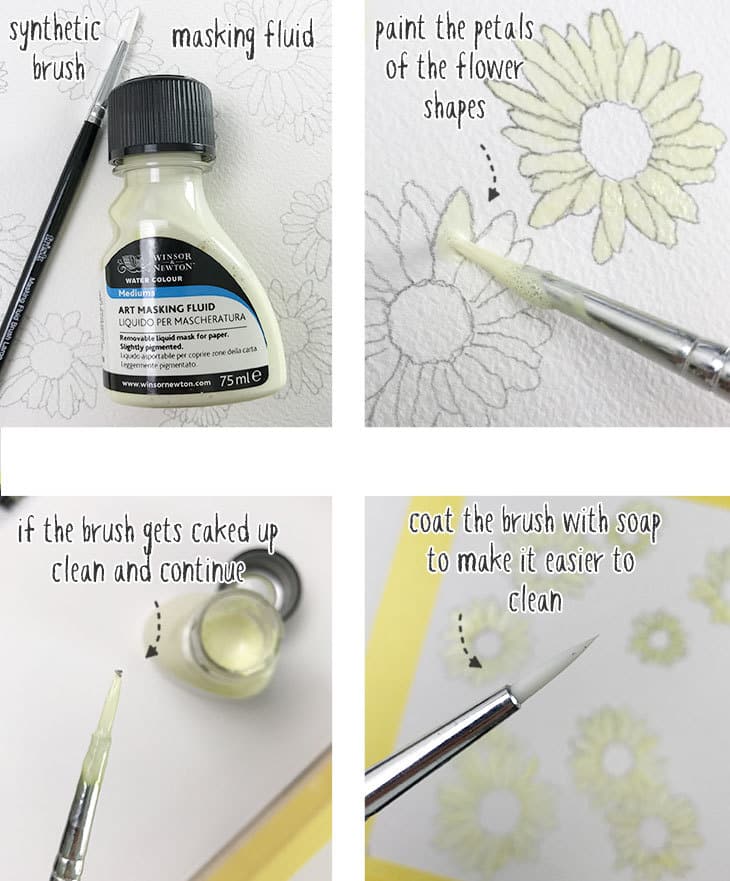
Mask all of your white petals but leave the yellow centers of the flowers so you can fill them in while the masking fluid is still on.
Leave the masking fluid to dry a few minutes before going on to the next stage.
Tips: You could try coating the tip of the brush with soap before using the masking fluid, This tends to make it easier to clean the brushes afterwards.
Also, when you do this phase of the project it’s best to do the background painting immediately after the masking fluid is dry. If you leave the masking fluid on too long there’s a small risk that it will stain the watercolor paper.
Step 5 – Paint a light toned wet on wet background
Wet on wet is a watercolor technique for producing beautiful blended colors. It literally means painting onto a wet surface.

Keep in mind, this stage needs to be painted quickly before the paper surface has time to dry. It’s a good idea to mix your colors first to save time. I used a light sap green and a darker leafy green.
Begin by dampening the whole of the background with clear water using a clean brush. Try to do this evenly without leaving puddles of water. Next, load your brush with some sap green and charge the wet paper with paint. You can paint unevenly so that you get patchy areas of lighter and darker tones. Try to make the bottom of the painting slightly darker by adding more pigment than the top.
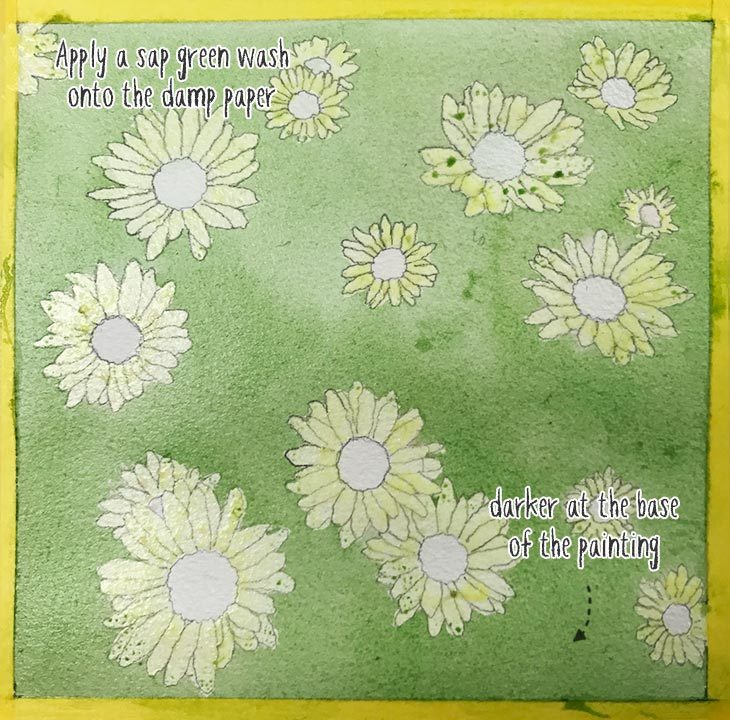
Now you can load your brush with darker paint and add some darker tones around the bottom edges of the flowers and the base of the painting.
Finally rinse your brush and load it with clear water. Flick the brush a couple of times over the painting so that drops of water fall into the wet wash creating splatters.
Splatters with clear water add texture to a wet wash, but the technique can also be used with a brush loaded with color.

Step 6 – Paint the center of the flowers
Using a mix of pure New Gamboge, paint the yellow centers of the flowers, but don’t fill them in completely. Leave some of the white paper untouched. I’m imagining the direction of the sunlight to come from above on the right hand side. With this in mind I tried to leave some white highlights in the yellow centers in the upper right hand spot.
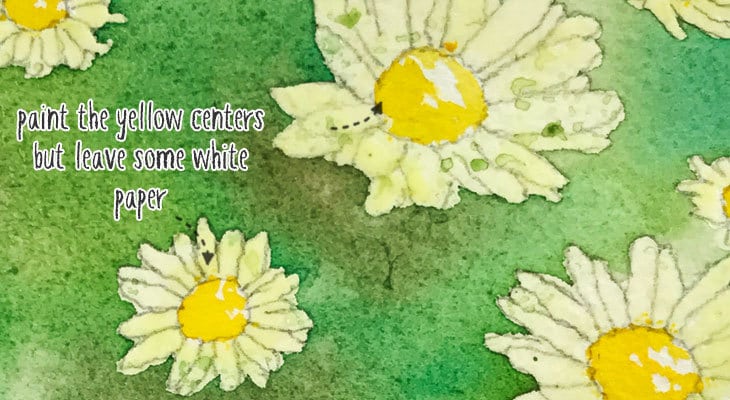
Step 7 – Add a dark toned wet on dry background
This is where you need a little patience. You need to let the wet background dry before moving on to the next stage.
Take a break, make yourself a coffee, and congratulate yourself on the progress so far!
When your painting is dry, mix a new dark green color. We’re going to add another layer of paint to the background using a technique known as glazing. The term glazing means “layering” paint on top of an already dry wash. This is a wet on dry technique which means you must paint on a dry surface.
Laying down successive layers of paint increases the richness and deepens the tone of your watercolors.
The aim is to create a background which suggests leaves and vegetation without accurately painting any detail. Load your brush with dark green paint and brush around the flowers, being careful not to touch the yellow centers. Paint using random brush strokes in a haphazard way. This technique of painting is known as scumbling. It’s a bit like scribbling with your brush.
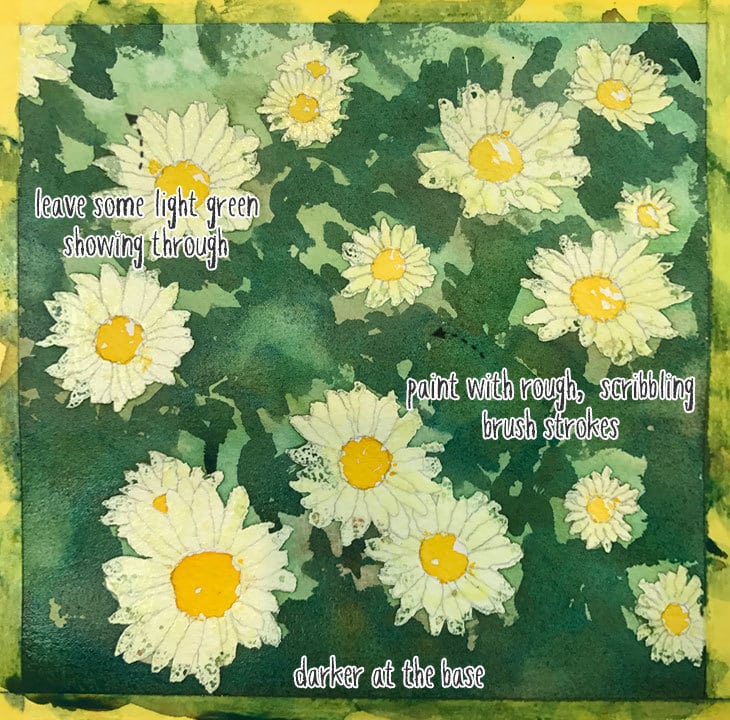
The idea is to leave some of the previous lighter background visible. Try to add more paint to the base of the painting and leave more of the light background visible at the top.
Tips: I have to admit I do sometimes cheat and use a hair dryer to help the paint dry quicker.
Step 8 – Remove the masking fluid
Leave the last wash to dry completely. You can now remove the masking fluid for the final part of the exercise.
I find the easiest way to do this is using a kneaded eraser (sometimes called a putty rubber). This is a pliable eraser that you can be shaped by hand for more precise erasing and has the advantage of not leaving any residue when erasing.

Use it in the same way as you would for removing pencil marks. It will help lift the dried masking off the paper to reveal crisp white flower petals underneath.
Step 9 – Add detail to the petals
Now you can add some details to the petals. Mix up a very light grey color (for example using Quinacridone rose and Phthalo green). Make sure your paint is very diluted and thin to get a light toned grey. If you’re paint is too thick the effect will look exaggerated.
Paint the edges of the petals and add some shadow to some of the rear, overlapped petals to give a sense of depth. Use your pencil outline as a guide and paint these details wet on dry. You can use glazing to add additional layers of grey to reinforce shadows where you think they’re needed. For example I put grey shadow on the left side of the yellow flower centers.
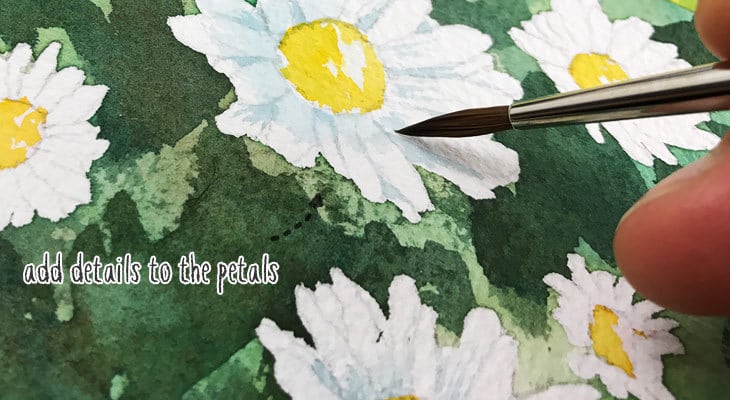
Step 10 – Complete the final details
Mix some orange paint to add shading to the yellow centers. Paint the edges of the flower centers on one side only to give a sense of three dimensional form.
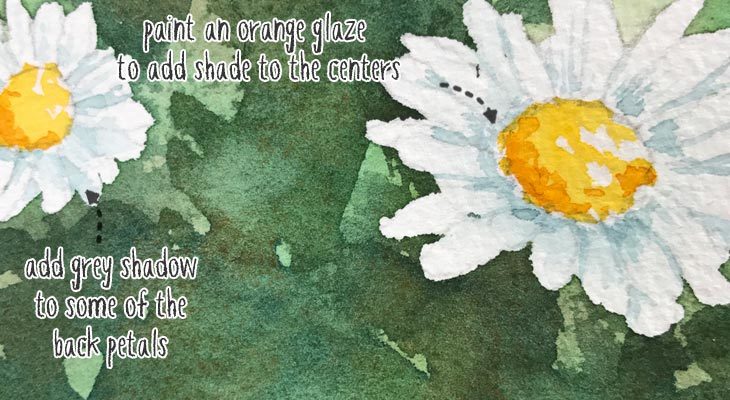
That’s it ! Leave your painting to dry and then remove the paper from the board, being careful not to rip the paper surface. If you’re using low tack masking tape you should be fine.
Hope you enjoyed this little tutorial and you now have a new painting to add to your collection !



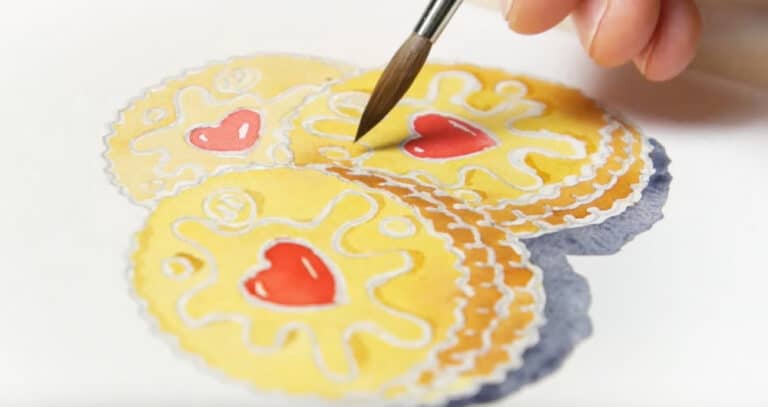
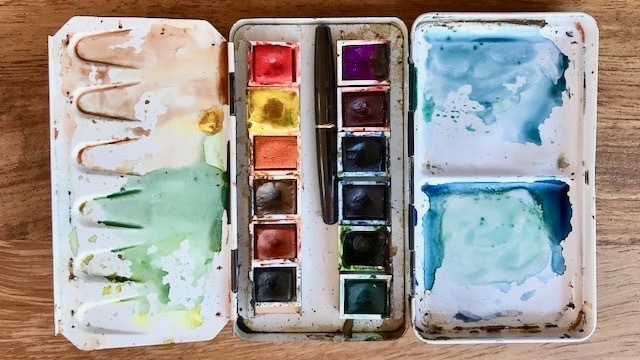


Excellent. I get such good results doing your tutorials! My next will have coneflowers with black eyed Susan’s. Thank you!
Happy to hear you’re enjoying your watercolors Charles!
Amazing tutorial Anthony! Thank you for sharing.
Glad you liked it Jasmine 🙂
Loved the tutorial, the sequencing of the steps demonstrating the process and the techniques. Thank you. I’m going to try this painting.
I learned more about techniques from reading this than I have learned watching hours of videos. Thanks for showing me new possibilities.
Thanks Carol ! Happy you enjoyed it !
I am new to watercolor. Thank you for sharing your wisdom and knowledge, as well as attention to detail. Much appreciated.
You’re welcome bunny !
Thank you so much for sharing. I am so enthusiastic about starting waterpainting but have no clue where to start. Now I know: with this.
you are awesome. so much of pain youve taken to make this blog and each article. i appreciate your hard work so much….God bless u always
Thank you Christina!
Wow,great lesson for this soon to be beginner. I learned much,thank you
Peggy
Hi
It was fantastic. Thank you..
You’re welcome !
WONDERFUL Post.thanks for share..extra wait .. …
Thanks Doris… Hope you have fun painting them!
I like this weblog very much so much fantastic information.